Diabetes is a chronic condition that affects millions of people worldwide, leading to various complications if not managed properly. One significant concern for individuals with diabetes is the increased risk of leg infections, including diabetic foot infections and leg ulcers. This article will delve into the causes, symptoms, and effective management strategies for diabetic leg infections and foot ulcers.
The Link between Diabetes and Leg Infections:
People with leg infection in diabetic often experience impaired blood circulation and nerve damage, particularly in the extremities. This combination can lead to reduced sensation in the legs and feet, making individuals with diabetes more susceptible to injuries and infections. The most common cause of leg infections in diabetics is a small cut or wound that goes unnoticed due to neuropathy.
Diabetic Foot Infection:A way of increasing the risk of infections
Diabetic foot infection is a severe complication that arises when a wound or sore on the foot becomes infected. The lack of sensation in the feet makes it challenging for individuals with diabetes to detect injuries, allowing infections to develop unnoticed. Moreover, compromised blood flow hinders the body's ability to fight infections effectively.
Symptoms of Diabetic Foot Infections:
Pain and Swelling: The affected foot may become swollen and painful.
Redness and Warmth: The skin around the infected area may appear red and warm to the touch.
Pus or Drainage: If an infection occurs, pus or other fluids may drain from the wound.
Foul Odor: An unpleasant smell from the wound may indicate infection.
Diabetic Leg Ulcers:
Diabetic leg ulcers are another common complication in individuals with diabetes, often resulting from poor circulation and nerve damage. These ulcers are open sores that may take an extended period to heal, increasing the risk of infections.
Diabetic leg ulcersare another common complication in individuals with diabetes.
Causes of Diabetic Leg Ulcers:
Poor Blood Circulation: Diabetes can lead to atherosclerosis, a condition where the blood vessels become narrow, reducing blood flow to the legs.
Neuropathy: Nerve damage can cause loss of sensation, making people with diabetes unaware of injuries that could lead to ulcers.
Compromised Immune Function: Diabetes can weaken the immune system, making it harder for the body to fight infections and heal wounds.
Management of Diabetic Leg Infections and Ulcers:
Wound Care: Proper wound care in diabetic foot ulcer is crucial for preventing and managing infections. Cleaning the wound with mild soap and water, applying antibiotic ointment, and keeping it covered with a sterile bandage is essential.
Blood Sugar Control: Maintaining optimal blood sugar levels is fundamental in preventing complications in diabetics. Consistent monitoring, medication adherence, and lifestyle modifications are vital components.
Foot Hygiene: Regular foot hygiene is essential for preventing infections. People with diabetes should inspect their feet daily, moisturize to prevent dryness and cracking, and trim toenails carefully to avoid injuries.
Compression Therapy: For individuals with poor circulation, compression stockings can help improve blood flow and reduce the risk of ulcers.
Medical Intervention: In severe cases, medical intervention may be necessary. This could include debridement (removal of dead tissue), antibiotics, and, in extreme cases, surgery to improve blood flow.
Prevention Strategies:
Regular Check-ups: Diabetics should have regular foot exams to detect potential issues early on.
Proper Footwear: Wearing comfortable and supportive shoes can prevent injuries and reduce the risk of developing ulcers.
Quit Smoking: Smoking can worsen circulation problems; quitting is beneficial for overall vascular health.
Healthy Lifestyle: Adopting a healthy lifestyle with a balanced diet and regular exercise can contribute to overall well-being and aid in managing diabetes.
Conclusion:
Leg infections in individuals with diabetes, including diabetic foot infections and leg ulcers, are serious complications that require diligent management. Through proper wound care, blood sugar control, and preventive measures, diabetics can reduce the risk of infections and enhance their overall quality of life. Regular monitoring, prompt medical attention, and a commitment to a healthy lifestyle are essential components in the holistic approach to managing leg infections in people with diabetes.
For more information about diabetic foot ulcer, click here to Advanced Oxygen Therapy Inc. for the best wound care or healing programs.


No comments yet